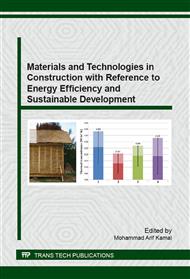[1]
M. R. Samidi: First report research project on lightweight concrete, University Teknologi Malaysia, Skudai, Johor Bahru, (1997).
Google Scholar
[2]
Application on Litebuilt @ Aerated and Composite Concrete by PTY LTD.
Google Scholar
[3]
B. Keertama, S.S. Mani and M Thenmozhi: Utilization of eco sand and flyash in aerated concrete for the richest mix design. Int. Journal of Engg. Science & Tech. Vol3 (2011), pp.299-304.
Google Scholar
[4]
M.R. Jones & A. McCarthy : Preliminary views on the potential of foamed concrete as a structural material. Mag. Concr. Res. 57 (1), pp.21-31, (2005).
DOI: 10.1680/macr.2005.57.1.21
Google Scholar
[5]
S. Chandra and L Berntsson : Lightweight aggregate concrete: science, technology and applications, Noyes Publications.
Google Scholar
[6]
O.A. Kayali and M.N. Haque : A new generation of structural lightweight concrete" ACI, SP-121, pp.569-588, (1997).
Google Scholar
[7]
M. Berra and G. Ferrara: Normal weight and total-lightweight high strength concretes: A comparative experimental study, SP-121, pp.701-7334, (1990).
DOI: 10.14359/2576
Google Scholar
[8]
J.V. Martins, P.V. Hobbs, R.E. Weiss and P. Artaxo, Sphericity and morphology of smoke particles from biomass burning in Brazil. Journal of Geophysical Research, Vol. 103, No. D24, p.32, 051 - 32, 057, (1998).
DOI: 10.1029/98jd01153
Google Scholar
[9]
Q. Tang, G. Liu, C. Zhou and R. Sun, Distribution of trace elements in feed coal and combustion residues from two coal-fired power plants at Huainan, Anhui, China. Fuel, Vol. 107, pp.315-322, (2013).
DOI: 10.1016/j.fuel.2013.01.009
Google Scholar
[10]
Concrete Masonry Units-Specification, Preformed Foam Cellular Concrete Blocks BIS 2185, (2008).
Google Scholar
[11]
Methods of test for autoclaved cellular concrete products, IS 6441 (part V).
Google Scholar
[12]
Specifications for 43 grade Ordinary Portland Cement, BIS 8112, (2005).
Google Scholar
[13]
C.W. Tang: Hydration behaviour of cement pastes containing high volume mineral admixtures, Computers & Concrete, pp.17-38, (2010).
DOI: 10.12989/cac.2010.7.1.017
Google Scholar
[14]
G. Rudnai: Lightweight concretes, Budapest, Akademikiado, (1963).
Google Scholar
[15]
IS: 3346, Method for determination of thermal conductivity of thermal insulation materials (Two slab, Guarded hot plate method).
Google Scholar
[16]
V. Sood, B.M. Suman, & A. Kumar : Effect of admixtures on the physical properties of non – autoclaved light weight blocks using pond ash, IJoRT, Vol. 3 Issue 8, (2014).
Google Scholar
[17]
B.M. Suman & V. Kumar, Thermal behaviour of EPS concrete (2012), The Indian concrete journal Vol. 86 No. 6, pp.56-59, (2012).
Google Scholar
[18]
B.M. Suman, R.K. Srivastava & R. Chauhan: Procd. Trends & Challenges in structural engineering & construction technologies, CBRI, (2009).
Google Scholar
[19]
BRN 12, Non – erodible mud plaster on mud wall for rural housing, CBRI.
Google Scholar
[20]
N. Narayan & K. Ramamurthy, Micro structural investigations on aerated concrete, Cem & Concr Res, pp.457-64, (2000).
Google Scholar
[21]
K. Ramamurthy, E.K. Kunhanandan, G.I. S Ranjani:, A classification of studies on the properties of foam concrete, Cement & Concrete Composites, pp.388-396, (2009).
DOI: 10.1016/j.cemconcomp.2009.04.006
Google Scholar


